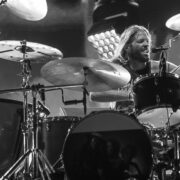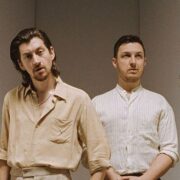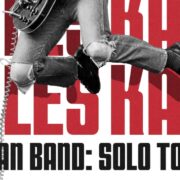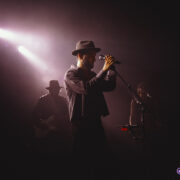Dopo un’assenza di cinque anni, lo scorso marzo i Cruachan sono tornati con il nono album in studio, “The Living And The Dead“, che vede i pionieri del folk metal ancora in grandissima forma, malgrado i i tanti lustri sulle spalle e significativi cambi di line-up. Un disco previsto per il 2020, ma la cui pubblicazione è stata posticipata a causa dello scoppio della pandemia, evento paradossalmente fruttifero per una band quasi del tutto nuova, bisognosa di rodaggio sia in studio che dal vivo. Abbiamo discusso di questo e di molto altro con il leader assoluto degli irlandesi Keith Faith, che, tra aneddoti divertenti e considerazioni più serie, rivela un amore per la propria band davvero sconfinato. In barba all’Eurovision e a James Joyce.
— SCROLL DOWN FOR THE ENGLISH VERSION —
Ciao Keith e benvenuto su SpazioRock. Grazie per il tuo tempo. Come va? Il nuovo album dei Cruachan, “The Living And The Dead”, è stato pubblicato lo scorso marzo. In realtà, il disco sarebbe dovuto uscire nel 2020, ma la pandemia ne ha posticipato il rilascio. Cosa è successo in questi ultimi due anni?
Nel 2020 abbiamo preso a bordo quattro nuovi membri. Ciò è avvenuto al culmine della pandemia, emergenza che in realtà ha giocato a nostro vantaggio. Ci ha dato il tempo di cui avevamo bisogno per rodarci, così, quando le cose sarebbero tornate alla normalità, saremmo stati pronti per risalire sul palco. So che molte formazioni hanno pensato di farla finita durante il COVID-19 e tante persone, probabilmente, hanno pensato che fosse qualcosa che avrei potuto fare anch’io di fronte all’enorme compito di sostituire così tanti componenti del gruppo, ma non c’era maniera che lo facessi, ho lavorato sin troppo duramente e a lungo per portare i Cruachan dove sono in questo momento e non c’è modo al mondo di porre fine alla band. Ora abbiamo una line-up più forte che mai e le migliori capacità musicali a disposizione, quindi non potrei essere più felice del nostro futuro di quanto lo sia adesso.
Puoi parlarci un po’ più a fondo di questi cambi di line-up?
Dunque, Joe Farrell è arrivato al basso all’inizio del 2020, quando siamo tornati dal 70000 Tons Of Metal. Abbiamo avuto molti problemi con Rustam Shakyrzianov che suonava il basso con noi da un anno, quindi abbiamo deciso che sarebbe stato meglio per lui andarsene. Joe è stato il nostro batterista per quasi dieci anni. Lasciò il gruppo, ma rimase un caro amico e per anni parlammo della possibilità di un suo ritorno, così, quando Rustam è andato via, gli ho chiesto se fosse interessato a tornare a suonare il basso. Era perfetto ed è fantastico riavere un vecchio membro nella band. Il nostro batterista Mauro Frison si stava trasferendo in Svezia con la sua famiglia. Abbiamo provato a pianificare un modo in cui potesse farlo e restare nella band, ma non è stato possibile. Il COVID-19, in realtà, ha ritardato la sua partenza, quindi è stato in grado di registrare il singolo di “The Hawthorn” con noi, ma alla fine è andato via e abbiamo reclutato Tom Woodlock alla batteria. La più grande preoccupazione che avevo era cercare di trovare un musicista folk. Audrey Trainor mi ha inviato alcuni video di audizioni e mi ha letteralmente sbalordito. È una musicista incredibile e non potevo credere che stesse chiedendo di unirsi a noi, ha portato tanto ai Cruachan da quando è entrata a farne parte, tutti i nuovi membri lo hanno fatto e siamo entusiasti di essere in tour con questa formazione. Anche il nostro secondo chitarrista Kieran Ball se n’è andato. Aveva praticamente finito di suonare dal vivo e questo gli ha dato il tempo di concentrarsi su ciò che voleva. Lo abbiamo sostituito con Dave Quinn, ma non ha funzionato, quindi ora stiamo continuando, almeno per il momento, con una sola chitarra elettrica.
Le copertine degli album dei Cruachan sono sempre state molto affascinanti e significative. L’ultimo artwork è stato creato da Vagelis Petikas e rappresenta tutte le sfaccettature del disco. Gli hai dato qualche suggerimento o è stato ispirato direttamente dalle canzoni?
Il progetto, e te ne accorgi se esamini l’intera copertina, era quella di rappresentare il titolo “The Living and The Dead”. Probabilmente hai visto solo quella che è la copertina “anteriore”, la parte di The Living, piena di simboli di vita e con la presenza di una donna guerriera dall’aspetto molto gaelico. Sulla sezione “posteriore”, vedrai la parte di The Dead, una suora malvagia circondata da immagini di morte. Ho dato l’idea del tema a Vagelis, ma lui ha avuto quella dell’artwork diviso, che funziona molto bene.
A proposito del titolo, esso è stato cambiato durante la realizzazione dell’album. Il disco originariamente doveva chiamarsi “Forests Songs”. Perché hai deciso di cambiarlo?
È avvenuto durante le registrazioni, mentre cantavo. Mick, il produttore, stava ascoltando il testo di “The Ghost”, o forse “The Reaper”, non ricordo esattamente, ma non dimenticherò mai che si è voltato verso di me e ha detto: “Perché l’album si chiama “Forest Songs”?”. Ho pensato per un minuto e gli ho risposto: “Hai assolutamente ragione!”. Il titolo doveva cambiare per adattarsi davvero al contenuto delle liriche, quindi abbiamo scelto una delle nostre idee originali: “The Living And The Dead”.
Ho trovato la produzione di Michael Richards molto naturale, capace di esaltare il sound dei tanti strumenti tradizionali presenti. Inoltre, in “The Reaper”, la figlia quattordicenne di Michael, Sinead, suona l’euphonium. Possiamo dire che c’è totale armonia tra i Cruachan e la famiglia Richards?
Sì, ora c’è davvero (ride, n.d.r.). Lavoriamo con Mick da oltre dieci anni e ha lasciato un segno in tutti i nostri album. Ha un ottimo set-up, non solo la migliore attrezzatura per la registrazione, ma anche gli strumenti: ho usato le sue chitarre per tutte le nostre registrazioni.
Rispetto alla splendida Blood Trilogy, il nuovo full-length, pur essendo 100% Cruachan, suona leggermente meno estremo e più equilibrato dal punto di vista sonoro. Il metal è ancora molto presente, ma la componente folk ha il suo peso. Sei d’accordo?
No, non sono affatto d’accordo, il nuovo album è pesante ed estremo come tutti i nostri lavori recenti, l’unica eccezione è che non ci sono così tanti blast-beat. Non era intenzionale, è solo come sono andate le cose con le canzoni su cui ho scelto di lavorare e con le quali finalizzare l’album. Ci sono un sacco di parti di puro death metal in tutto “The Living And The Dead”.
“The Living And The Dead” non è certo un concept album, ma i temi delle canzoni si rifanno in parte ad antiche credenze e leggende pagane e in parte a eventi reali. Quanto è importante l’eredità delle tradizioni in Irlanda oggi? Si avvertono in maniera più intensa rispetto al resto del mondo?
Quando ho iniziato a scrivere il nuovo lavoro, non avevo intenzione di avere un tema centrale. Il disco precedente, “Nine Years Of Blood”, era un concept album, quindi ero felice di tornare a scrivere brani su ciò che volevo. La prima canzone che ho scritto è stata “The Queen” e puoi sentire che è un po’ diversa dal resto dei pezzi, potrebbe quasi adattarsi al full-length precedente. Ho quindi iniziato a scrivere testi sulla classe contadina e operaia dell’Irlanda intorno ai primi del 1700 (“The Harvest”, “The Changeling”), poi è successo qualcosa. Il rapporto Mother And Baby Homes è stato pubblicato in Irlanda. Per favore, cercatelo su Google per saperne di più. Ho sempre saputo di queste case, delle lavanderie Magdelin, dell’orrendo comportamento generale della Chiesa cattolica qui. Ci sono stati molti libri e film sull’argomento nel corso degli anni, ma quando questo rapporto è stato pubblicato, ha avuto un certo effetto su di me e ho deciso di scrivere alcune canzoni su questo soggetto. Quindi, metà del lotto è basata su questo, ma il tutto legato insieme nel tipico stile Cruachan; a esempio, “The Crow” parla chiaramente dei bambini morti per mano di queste suore, ma il corvo della canzone si riferisce alla dea Mórrígan (divinità irlandese mutaforma, ndr). Per quanto riguarda le tradizioni che citi, ce ne sono molte in Irlanda, specialmente nelle parti più rurali della nazione, ma non tanto nelle città e nei paesi più grandi.
Ci sono davvero molti ospiti che contribuiscono all’album. Uno dei più curiosi è un attore come Jon Campling, che ha partecipato ai cori in “The Crow” e “The Changeling”. Perché lo hai scelto? O è lui che si è offerto?
Beh, questa è una storia interessante (ride, ndr). Jon ha interpretato il ruolo di un Mangiamorte negli ultimi due film di Harry Potter (è il tizio che ferma l’Espresso per Hogwarts). Non è un segreto che sono un grande fan di Harry Potter e faccio parte del team che organizza il Dublin Wizard Con, una convention su Harry Potter qui a Dublino. Alcuni anni fa, abbiamo avuto Jon come ospite speciale alla manifestazione ed è lì che è iniziata la nostra amicizia. All’epoca, Jon stava imparando a suonare la chitarra e a cantare, quindi gli ho chiesto se gli fosse piaciuto fare il suo debutto musicale su un album dei Cruachan e ha colto al volo l’occasione, era al settimo cielo. Quando alla fine abbiamo pubblicato il disco, mi ha inviato un messaggio dicendo – e cito testualmente: “Ascoltarmi, il nuovo album dei Cruachan mi ha dato la stessa, identica eccitazione di quando mi sono visto sullo schermo nei panni del Mangiamorte nei film di Harry Potter“. È stato un piacere avere Jon con noi.
“The Witch” è, per certi versi, una traccia interessante per i Cruachan. Ci sono forti vibrazioni hard rock e molti riferimenti ai Thin Lizzy, e non è un caso che l’assolo di chitarra sia stato suonato da Stu “La Rage” Dixon. Stu ha contribuito in qualche modo alla scrittura di questa canzone o volevi solo operare una variazione sul tema?
Sì, “The Witch” ha sicuramente un’atmosfera diversa e questo è stato molto intenzionale. Sono davvero orgoglioso delle liriche, sono state scritte prima della musica. Quando mi sono seduto e ho iniziato a lavorarci su, stavo entrando in una canzone folk di tipo death metal e ho pensato tra me e me: “No, voglio qualcosa che si distingua e faccia risaltare i miei testi”. Quindi, sono andato in una direzione completamente diversa e ho scritto un omaggio musicale agli irlandesi Thin Lizzy. Non ci sono fregature musicali o altro, volevo solo un brano che riecheggiasse quelle leggende ed è da lì che è venuta la musica. Stu non ha avuto alcun coinvolgimento, gli ho solo inviato la traccia finita, gli ho detto dove iniziava l’assolo, quali erano le mie idee e lui ha fatto il resto. Spacca alla grande su quell’assolo!
Un altro momento clou è “The Ghost”, forse una delle canzoni più aggressive del disco, con la presenza di Mathias “Vreth” Lillmåns che dà un tocco molto Finntroll al brano. Possiamo affermare senza reticenze che il celtic metal dei Cruachan abbia ispirato gli stessi Finntroll e molte altre band del settore?
Grazie. Sai, originariamente Kelly Schaefer degli Atheist doveva cantare quella canzone, ma la nostra registrazione si è scontrata con il suo tour, quindi non è successo, sono tornato al mio Heavy Metal Rolodex e ho chiesto a Mathias se fosse interessato. Penso che non ci siano dubbi sul fatto che l’esistenza dei Cruachan abbia influenzato molte delle band folk metal di oggi, e se non siamo stati degli ispiratori, abbiamo sicuramente spianato la strada affinché il folk metal diventasse il genere popolare che è oggi.
L’album si conclude con la cupa “The Dead”, che mi ha ricordato l’atmosfera dell’omonimo racconto di James Joyce che chiude “Gente Di Dublino”, benché il testo non si riferisca a esso. Qual è, in ogni caso, il tuo rapporto con il grande scrittore irlandese?
Onestamente, non ho mai letto nessuno dei lavori di Joyce, a parte ciò che facevo a scuola. Forse è ora di cambiare (ride, ndr).
I Cruachan hanno lavorato con tantissimi musicisti, ma credo che una delle collaborazioni più importanti sia stata quella con Shane MacGowan. Che ricordi hai di quell’esperienza indimenticabile?
Ho tanti ricordi e alcuni sono così bizzarri che non riesco nemmeno a condividerli. Quando abbiamo incontrato Shane per la prima volta per discutere di lavorare con noi, era da solo nel suo cottage nel profondo dell’Irlanda rurale. Era intorno al periodo natalizio e stava guardando “Lawrence D’Arabia” quando siamo arrivati. Ci ha offerto la bevanda che aveva a portata di mano, mio fratello John ha cenato con l’unica birra che c’era: una lattina molto calda di Budweiser. Entro un’ora dall’arrivo, Shane andò ad alimentare il fuoco del camino e quasi ci cadde dentro, John lo salvò. Quella è stata la prima di molte di queste storie, John che ha salvato Shane dal cadere in un incendio (ride, ndr.). Una grande storia che racconto spesso riguarda il suo genio. Un giorno era in ritardo, lo aspettavamo in studio, erano più o meno le 16:00 e neanche il nostro produttore era lì. Andammo all’hotel in cui Shane alloggiava, a pochi minuti a piedi dallo studio. Il personale di sicurezza ci conosceva e ci ha fatto andare direttamente nella sua stanza. Quando siamo entrati, era svenuto addormentato sul letto, ma la stanza era piena di pagine e pagine di testi o poesie, sparse ovunque. Era come la scena di un film. Non dimenticherò mai il tempo in cui abbiamo lavorato insieme e gli auguro molti altri anni di musica.
Avete presentato “The Blacksmith” all’Irish Eurosong 2023, ma sfortunatamente la canzone non è stata selezionata per l’Eurovision Song Contest di maggio. Come hai vissuto questa delusione? Penso che i Cruachan avrebbero rappresentato le vere tradizioni musicali irlandesi meglio dei Wild Youth …
Pensavamo di avere una vera possibilità di offrire qualcosa di nuovo per l’Irlanda all’Eurovision. La stampa e i media lo credevano come noi, visto che siamo stati ospiti in molte delle stazioni radio nazionali, anche i giornali hanno raccontato la storia. In realtà, ce la siamo cavata bene, dalle circa 300 iscrizioni iniziali siamo arrivati alle ultime dieci, ma alla fine non siamo giunti alle ultime sei che vanno alla finale televisiva. Penso che i giudici irlandesi abbiano ancora paura di provare qualcosa di diverso e ancora una volta tutte e sei le candidature per la finale televisiva erano musica pop. Ci riproveremo per il 2024.
Lo scorso anno i Cruachan hanno compiuto trent’anni. Quali sono stati i momenti più difficili della vostra carriera?
Abbiamo compiuto trent’anni l’anno scorso nel 2022 e abbiamo tenuto un concerto celebrativo a Dublino, è stata una serata davvero fantastica. Per quanto riguarda i momenti difficili, beh, ne abbiamo avuti molti, a essere onesto. Uno dei peggiori è stato quando abbiamo finito di registrare l’album “The Morrigan’s Call”. Abbiamo affittato lo studio, il costo era di 20.000 euro (oggi gli studi non costano neanche lontanamente questi prezzi). Avevamo firmato un contratto con la Black Lotus Records e proprio quando abbiamo finito di registrare, sono falliti. Quindi, lo studio non poteva essere pagato e il proprietario era un tale incubo per noi. Ci minacciava, insisteva perché prendessimo prestiti personali per pagare l’affitto e alla fine voleva portarci in tribunale. È stato assolutamente orribile. Alla fine, abbiamo firmato con la AFM Records, che ha coperto i costi di registrazione e ha pubblicato l’abum.
I vostri spettacoli dal vivo sono fantastici. Ci sarà un tour per supportare il nuovo album? Magari anche in Italia?
Grazie mille. Al momento, non ci sono reali piani di tour, ma siamo sempre aperti alle offerte di qualsiasi agente. Abbiamo in programma di partecipare a quanti più festival possibili, ma quest’anno abbiamo avuto difficoltà a prenotarli, poiché molti si stanno ancora riprendendo dagli effetti del COVID-19. Penso, però, che il 2024 sarà un anno epico per noi.
Grazie mille per l’intervista. Potresti lasciare un messaggio ai vostri fan italiani e ai nostri lettori?
Grazie a tutti coloro che hanno letto l’intervista e a tutti coloro che ci supportano, vecchi e nuovi fan. Non preoccupatevi, non molleremo!

— ENGLISH VERSION —
Hi Keith and welcome to SpazioRock. Thank you for your time. How are you doing? Your new album “The Living And The Dead” was released last March. The record was actually supposed to come out in 2020, but the pandemic postponed its release. What can you tell us about what happened during the last two years?
We actually had four new members come onboard throughout 2020. This was at the height of the pandemic which actually worked to our advantage, it gave us the time we needed to get all these new members up to speed, so when things got back to normal we would be ready to hit the stage. I know a lot of bands thought about calling it a day during Covid and a lot of people probably thought it was something I might do when faced with the huge task of replacing four band members but there was no way I would do that, I worked too hard and for too long to get Cruachan where it is and there is no way on earth I would end the band. We now have the strongest line up I’ve ever had, the best musicianship so I could not be happier about our future than I am right now.
Can you tell us more about these line-up changes?
So, Joe Farrell came in on bass at the start off 2020 when we got back from 70000 Tons Of Metal. We had a lot of issues with Rustam who had been on bass for a year so decided it would be best for him to depart. Joe was our drummer for almost ten years. He left the band but remained a close friend and for years we talked about the possibility of returning so, when Rustam went, I asked if he would be interested in coming back in on the bass. He was a perfect fit and it’s great to have an old member back in the band. Our drummer Mauro was moving to Sweden with his family. We tried to plan a way that he could do that and stay in the band but it wasn’t possible. Covid actually delayed his departure so he was able to record “The Hawthorn” single with us but eventually he did go and we brought Tom Woodlock in on drums. The biggest worry I had was trying to find a folk musician. Audrey sent me some audition videos and literally blew me away. She is an incredible musician and I couldn’t believe she was asking to join Cruachan. has brought so much to Cruachan since she came onboard, all the new members have and we are excited to be touring with this lineup. Our second guitarist Kieran also left. He was pretty much done with playing live and covid game him the time to focus on what he wanted. We did replace him with Dave Quinn but that didn’t work out so now we are continuing for the moment with just the one electric guitar.
Your album covers have always been very fascinating and meaningful. The last artwork was created by Vagelis Petikas and it represents all the facets of the album. Did you give him any suggestions or was he inspired by the songs?
The idea, when you see the whole album, is to represent “The Living And The Dead”. You’ve probably only seen what will be the ‘front’ cover – The Living part, which is full of life symbols and a very Gaelic looking warrior woman. On the fold out full cover, you will see The Dead part, an evil nun surrounded by imagery of death. I gave the idea for the theme to Vagelis but he came up with the split face idea which works really well.
Speaking of the title, it was changed during the making of the album. In fact, the album was originally supposed to be called “Forests Songs” Why did you decide to change it?
It was during the recording when I was doing vocals. Mick, the producer, was listening to the lyrics of “The Ghost”, or “The Reaper” (I can’t remember) but I’ll never forget him turning to me and saying “Why is this called Forest Songs?” and I thought for a minute and said “You’re absolutely right”. The title had to change to really suit the lyrical content so we went with one of our original title ideas – “The Living And The Dead”.
I found Michael Richards’ production very natural, capable of enhancing the sound of the many traditional instruments that you play. Also, in “The Reaper”, Michael’s 14-year-old daughter Sinead plays the euphonium Can we say that there is total harmony between the band and the Richards family?
Yes there really is now (he laughs, ndr.). We’ve worked with Mick for over ten years now and he has made a mark on all our albums. He has such a great set up, not only the best recording equipment but also instruments – I used Mick’s guitars for all our recordings.
Compared to the wonderful Blood Trilogy, the new full-length, despite being 100% Cruachan, sounds slightly less extreme and more sonically balanced. Metal is still very present, but the folk component has its importance. Do you agree?
No I don’t agree at all, the new album is as heavy and extreme as all our recent albums, the only exception is that there are not quite as many blast beats in there. That was not intentional, it’s just how things turned out with the songs I picked to work on and finalise for the album. There is a load of pure death metal parts all over the new album.
“The Living And The Dead” is certainly not a concept album, but the themes of the songs refer partly to ancient pagan beliefs and legends and partly to real events. How important is the legacy of traditions in Ireland today? Are they felt more intensely than the rest of the world?
When I first started to write the new album, I had no intention to have a central theme. The previous album, “Nine Years Of Blood”, was a concept album, so I was happy to get back to writing songs about what I wanted. The first song I wrote was “The Queen” and you can hear it’s a little different to the rest of the songs, could almost have fit on the previous album. I then started writing songs about the peasant and working class of Ireland around the early 1700’s (“The Harvest”, “The Changeling”) then something happened. The Mother And Baby Homes report was published in Ireland. Please Google that to find out more. I have always known about these homes, the Magdelin laundries, the overall horrendous behavior of the Catholic church here. There have been many books and movies about it over the years, but when this report was published, it had an effect on me and I decided to write a few songs on this subject. So, half the album is based on this but all tied together in typical Cruachan fashion, for example “The Crow” is clearly about the dead children at the hands of these nuns, but the crow in the song is The Mórrígan. As for the traditions that you mention, there are a lot of traditions in Ireland, especially in the more rural parts of the county, but not so much in the bigger cities and towns.
There are many guests who contribute to the album. One of the most intriguing is an actor like Jon Campling, who did the backing vocals in “The Crow” and “The Changeling”. Why did you choose him? Or did he offer himself?
Well, that’s an interesting story (he laughs, ndr.), Jon played the role of a Death Eater in the last two Harry Potter movies (he’s the guy that stops the Hogwarts Express). It’s no secret that I am huge fan of Harry Potter and I am part of the team that organise Dublin Wizard Con, a Harry Potter convention here in Dublin. A few years ago we had Jon as a special guest at the convention and that’s where our friendship started. At the time Jon was learning to play guitar and sing so I asked if he would like to make his musical debut on a Cruachan album and he jumped at the chance, he was over the moon. When we eventually released the album, he sent me a message saying, and I quote, “Hearing myself on the new Cruachan album gave me the exact same excitement as when I seen myself on screen as the Death Eater in the Harry Potter movies”. It was a pleasure to have Jon on the album.
“The Witch” is, in some ways, an interesting track for Cruachan. There are strong hard rock vibes and many Thin Lizzy references, and it’s no coincidence that the guitar solo was played by Stu “La Rage” Dixon. Did Stu have any input into the writing of this song or did you just want to make a variation on the theme?
Yes, “The Witch” definitely has a different vibe and that was very intentional. I am really proud of the lyrics, they were written before the music. When I sat down and started working on the music, it was going into a death metal type folky song and I thought to myself – “No, I want something that will stand out and make my lyrics stand out”. So, I went in a completely different direction and wrote a musical homage to Ireland’s Thin Lizzy. There’s no musical rip off or anything, I just wanted a song that musically echoed those legends and that’s where the music came from. Stu had no invovement at all, I just send the finished track to him, told him where the solo starts, what my ideas are and he did the rest. He absolutely slays on that solo!
Another highlight is “The Ghost”, possibly one of the more aggressive songs on the record, with the presence of Mathias “Vreth” Lillmåns bringing a very Finntroll edge to the track. Can we say without hesitation that Cruachan’s celtic metal has inspired Finntroll themselves and many other similar bands?
Thanks. You know – originally Kelly Schaefer from Atheist was to sing that song but our recording clashed with his touring so it just didn’t happen so I went back to my Heavy Metal Rolodex and asked Mathias if would be interested. I think there’s no doubt that Cruachan’s existence inspired many of todays folk metal bands, and if not inspired we definitely paved the way for folk metal becoming the popular genre it is today.
The album ends with the somber “The Dead”, which reminded me of the mood of James Joyce’s short story of the same name which closes “Dubliners”, although the lyrics don’t refer to it. In any case, what is your relationship with the great Irish writer?
Honestly I’ve never read any of Joyce’s work apart from what I did at school. Maybe it’s time to change (he laughs, ndr.)
You’ve worked with so many musicians, but I think one of your most important collaborations has been with Shane MacGowan. What memories do you have from that unforgettable experience?
I have so many many memories and some are so bizarre I can’t even share them. When we first met Shane to discuss working with us, he was alone in his cottage deep in rural Ireland It was around Christmas time and he was watching “Lawrence Of Arabia” when we arrived. He offered us what drink he had to hand, my brother John supped on the only beer that was there – a very warm can of Budweiser. Within an hour of arriving he went to stoke his fire and almost fell into it, John saved him. That was the first of many of these stories, John saved Shane from falling into a fire (he laughs, ndr.). One great story I often tell is around his genius. He was late to the studio one day, it’s 4pm and our producer is still not here. We went to the hotel he was staying at which was just a few minutes walk from the studio. The security staff knew us and let us go directly to his room. When we entered, he was crashed out asleep on the bed but the room was full of pages and pages of lyrics or poetry, scattered all over the room. It was like something from a movie. I’ll never forget the time we worked together and I wish him many more years of music.
You presented “The Blacksmith” at the Irish Eurosong 2023, but unfortunately the song was not selected for the Eurovision Song Contest in May. How did you experience this disappointment? I think Cruachan would have represented the real Irish music traditions better than Wild Youth …
We believed we had a genuine chance to offer something new for Ireland at Eurovision. The press and media felt the same as we were guests on many of our national radio stations, newspapers covered the story as well. We actually did ok, of the 300 or so submissions we did make it to the last ten but ultimately did not make the last six that go onto the televised final. I think the Irish judges are still afraid to try something different and again all six submissions for the televised final were pop music. We’ll try again for 2024.
Last year Cruachan turned thirty. What were the most difficult moments of your career?
We turned thirty last year in 2022 and had a celebration concert in Dublin, it was a really great night. As for difficult moments, well we’ve had lots if I’m honest. One of the worst was when we finished recording “The Morrigan’s Call” album. We hired the studio, costs were of 20,000 euro (studios cost nowhere near these prices today). We were signed to Black Lotus records and just as we finished the recording, they went bankrupt. So, the studio couldnt be paid and the owner was such a nightmare to us. Threatening us, insisting we take out personal loans to pay for the time and eventualy threatening to take us to court. It was absolutely awful. In the end, we signed with AFM Records who covered the recording costs and released the abum.
Your live shows are fantastic. Will there be a tour to support the album? And eventually there will be some shows in Italy?
Thank you so much. At the moment there are no real touring plans, but we are always open to offers of any bookers. We plan to get out to as many festivals as we can but have found it hard to book festivals this year as so many are still recovering from the effects of Covid. I think 2024 will be an epic year for us though.
Thank you very much for the interview. Would you leave a message to your Italian fans and to our readers?
Thanks to everyone who read the interview and to everyone that supports us, new fans and old. Don’t worry, we won’t be going anywhere!









